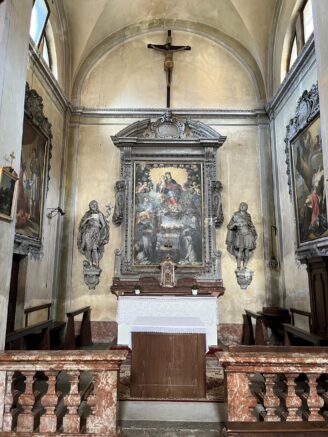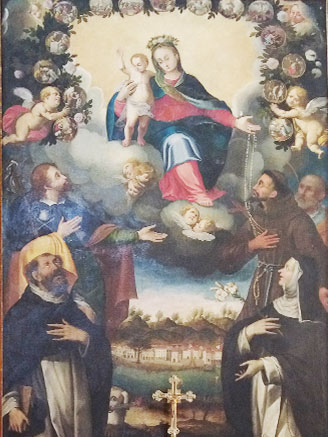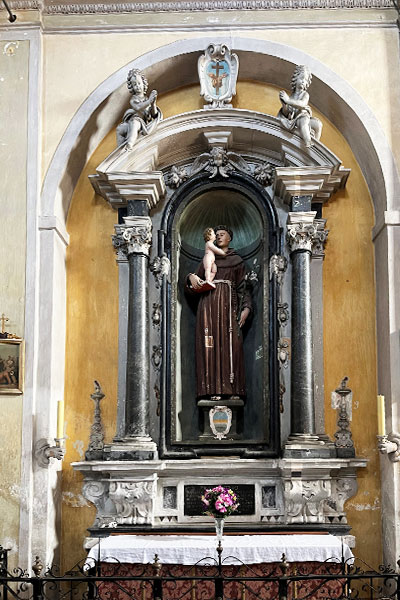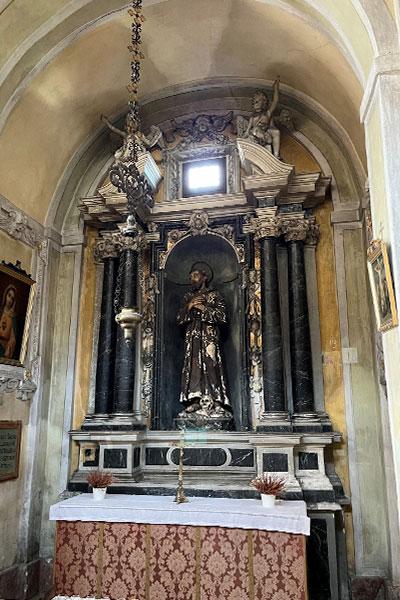2. Oratory of San Rocco
The Oratory was built in the 1630s on the site of a medieval chapel, some fragments of which can still be seen on the façade.
It marks the northern boundary of the old town and still maintains its original Baroque character, which is particularly evident in the elegant façade.
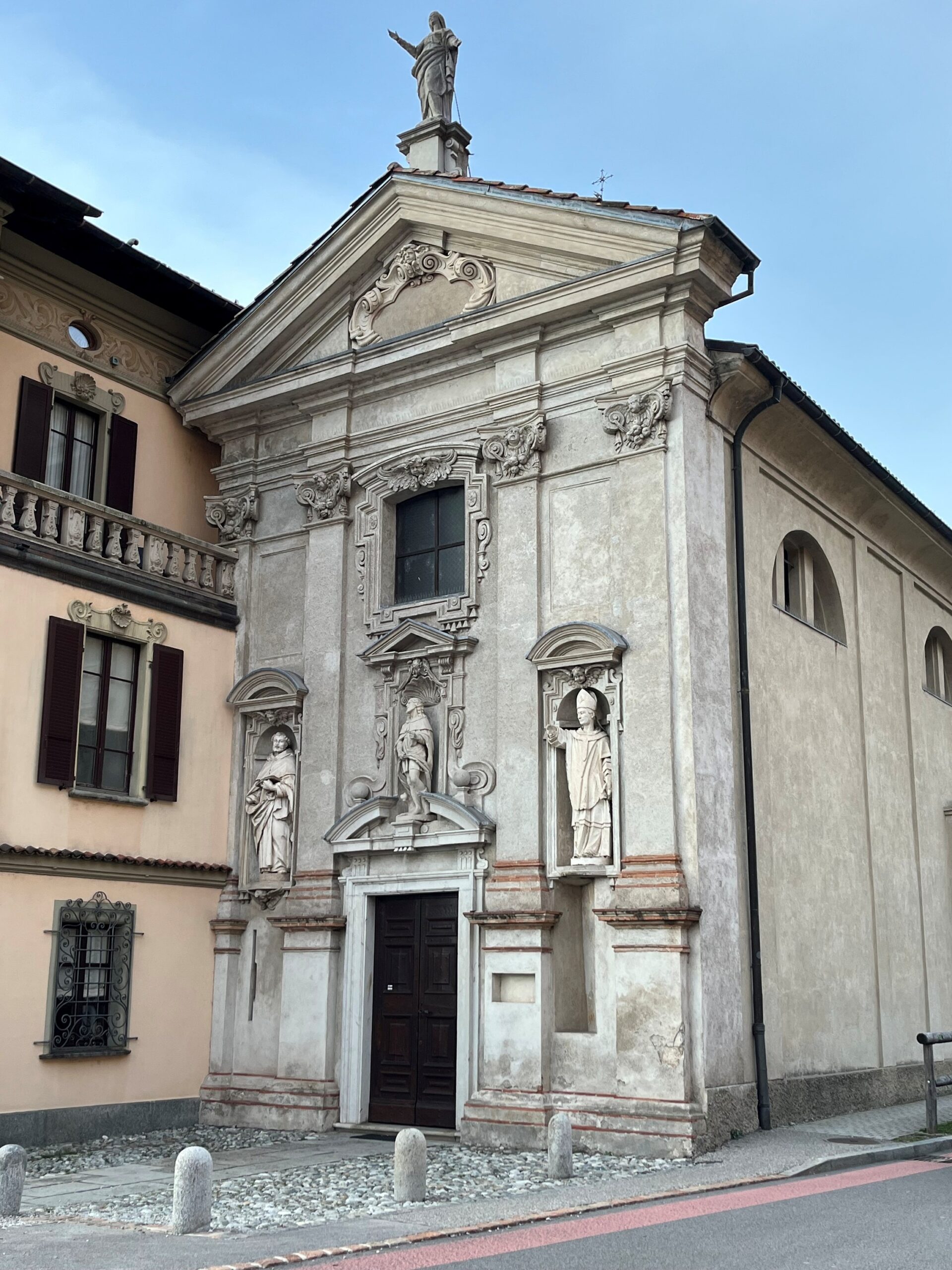
The history
The history
Its dedication to San Rocco suggests that it was built as a sign of gratitude or as a charm during the famous plague of 1630, which severely affected northern Italy and Ticino.
The letters “C.T.” engraved in the lintel above the main entrance door suggest the intervention of the architect and sculptor Costante Tencalla (c. 1590-1646), who had already worked in Rome with Carlo Maderno and in Poland with his uncle Matteo Castelli from Mèlide.

The most valuable element is the façade, which reflects the directives issued by San Carlo Borromeo, bishop of Milan, who believed that the façade should convey the initial message to the faithful as they entered the church.
The interior consists of a single central nave terminating with the choir, bordered by a balustrade. The high altar hosts an altarpiece surrounded by a stucco frame.
Two altars, one dedicated to St. Francis of Assisi, and the other to St. Anthony of Padua have been carved out of the side walls. Two notable statues located in consecrated niches, and made by the sculptor Giovanni Antonio Colomba from Arogno, represent St. Michael and St. Sebastian.
San Rocco
Due to his deep devotion to the Virgin Mary, the image of San Rocco is often found alongside representations of the Madonna. He is depicted with the tabarro (large cloak) covered by the tabarrino (small cloak that covers the shoulders), on which is fixed a shell that was used to collect water. In his right hand he holds the pilgrim’s staff. He often has a water bottle or a shoulder bag. On his right leg, is visible the wound caused by the plague. At his feet, a little dog with a piece of bread in its mouth recalls the period of his isolation in a cave, during which he was rescued by a dog that fed him every day.
San Rocco is the patron saint of the sick, travellers, healthcare workers and volunteers.
The Plague of 1630
The bubonic plague epidemic that spread throughout Europe between 1629 and 1633 was infamous, narrated in the famous work “I promessi sposi” by Alessandro Manzoni. The Duchy of Milan was one of the most affected regions. In northern Italy, a total of 1 100 000 people died out of a population of about 4 million. After its extinction, oratories, churches, chapels, tabernacles and votive columns arose everywhere to ward off its return.
Costante Tencalla
Son of Pietro Antonio (Giovan Pietro) and Lucia Castelli, Costante Tencalla was born in Bissone in 1590 and died in Warsaw in 1646. In 1620 he married Marta Porro. A stonemason and then a carver, he worked in Rome in the workshop of Carlo Maderno (1610-19, St. Peter’s and Castel Sant’Angelo). In Poland, from around 1630, he was the royal architect in Warsaw. He was particularly active in Vilna.
He also designed the bell tower of the collegiate church of San Lorenzo in Lugano (1632-33).
The façade
The façade is divided vertically by four pilaster strips, at the ends of which stand out richly decorated capitals. A triangular tympanum, topped by a statue of the Madonna, closes it at the top. At the centre of the façade, beneath the large window that illuminates the nave, stands the statue of San Rocco, to whom the oratory is dedicated. The two lateral niches contain two stucco statues, one representing a holy bishop, the other a holy monk, both unidentified.
In the spirit of the Counter-Reformation, the façade had to be linear, harmonious, without excessive ornamentation, enriched with sobriety by statues of saints dear to the local population or with allegorical figures.
The high altar and the altarpiece
The high altar is characterized by an altarpiece inserted in a stucco frame, surmounted by a curved tympanum, interrupted in the centre by a cartouche.
The altarpiece represents Saint Dominic (left) and Saint Catherine (right), kneeling before the Madonna, surrounded by angels and a garland of images relating to the Mysteries of the Rosary. Behind them are San Rocco (left) and Saint Francis (right).
Of particular interest is the agglomeration in the centre of the painting, which depicts Bissone as it appeared in 1640, the date of the work’s creation, attributed to the Genoese painter Giovanni Maria Arduino (1580-1647).
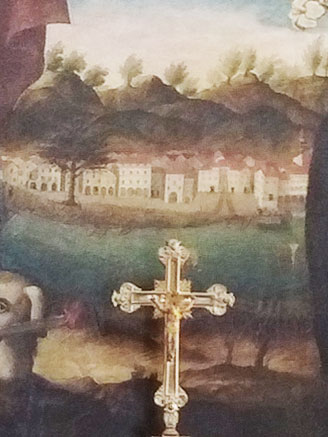
Detail of the altarpiece depicting the agglomeration of Bissone in 1640.
The canvas bears a notable resemblance to a similar work inserted in the chapel of the Madonna del Rosario, in the church of Santo Stefano in Arogno.
To the right and left of the altar, resting on shelves, are the stucco statues of St. Jhon the Baptist and St. Carpoforo.
Saint Michael and Saint Sebastian
In special niches in the side walls are placed two valuable stucco statues by the sculptor Giovanni Antonio Colomba of Arogno, also author of the stuccos in the chapel of the Madonna del Rosario in the parish church of Arogno.
Made between 1636 and 1644, they represent Saint Michael defeating Satan and Saint Sebastian.
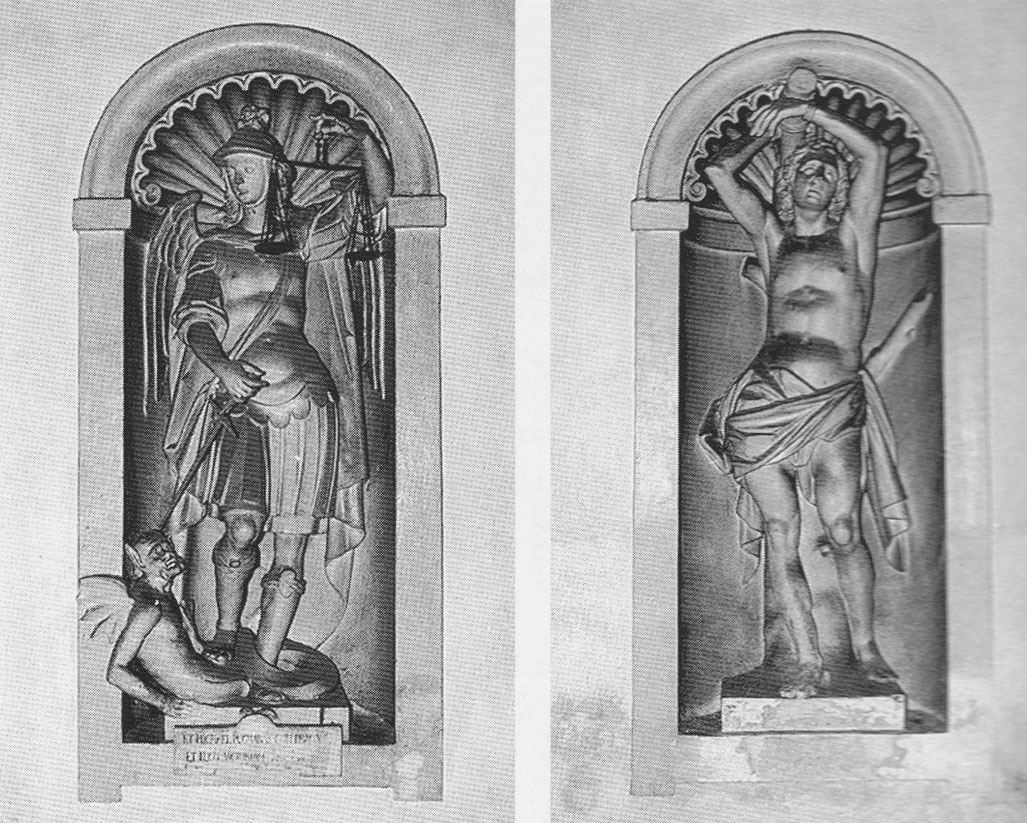
Saint Michael Saint Sebastian
Saint Michael Saint Sebastian
Side altars
The two side altars have a similar structure, which is characterized by the presence of fake marble columns surmounted by a curvilinear pediment and the presence of pedestals. A central niche houses the titular saint.
The altar on the left is dedicated to Saint Francis of Assisi and was sponsored in 1652 by Captain Francesco Tencalla. The one on the right houses Saint Anthony the Abbot and was built in 1651 by Giovanni Tencalla, as confirmed by an inscription under the niche and the family coat of arms at the top.

